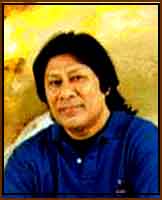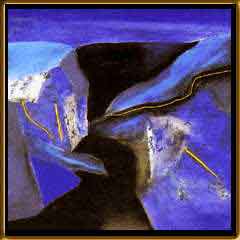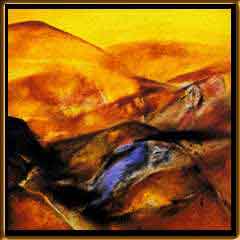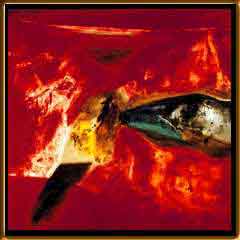|
Faces of India Laxman Shreshtha
| |||||
Yesterday I rang Sunita and Laxman Shreshtha, just to say "Hello, I was remembering you". Sunita's warm response was, "We just returned from Nepal, and we were thinking of you there." She always greets me like an old friend, seemingly continuing a conversation we left mid-way. The last time I had met the Shreshthas, I had urged them to visit the mountains where Laxman had grown up, and which are the inspiration for much of his abstract paintings. |
Faces of India • Swami Vivekananda • Shabana Azmi • Amitabh Bachchan • Pilot Baba • Mahesh Mathai • Atul Dodiya • Rakesh Mehra • Kiran Nagarkar • Zakir Hussain | ||||
 I have not met them more than a handful of times, but I have spent a couple of long afternoons that spilled into evening, in conversation with them. As I have felt every time I have met an 'artist', in the true sense of the word, I have been enriched by meeting them. We sat talking about life and what is meaningful, sitting in the midst of Laxman's paintings, which I had the effrontery to discuss at great length, even though I am not an art critic. I have not met them more than a handful of times, but I have spent a couple of long afternoons that spilled into evening, in conversation with them. As I have felt every time I have met an 'artist', in the true sense of the word, I have been enriched by meeting them. We sat talking about life and what is meaningful, sitting in the midst of Laxman's paintings, which I had the effrontery to discuss at great length, even though I am not an art critic.
Years ago, I first met him when I did a write-up on him for "The Independent". Much later, when Gentleman had wanted to do a feature on him, he had requested them to have me write it. Later still I walked into their house for a shoot with a TV production team who had an appointment with him. Sunita hugged me and told Laxman, "Look who is here!" The interviewer offered that I should do the interview, which I declined, since it was a face-to-face, and I only did off-camera interviews. It was a fun shoot, very relaxed, but when we left, Laxman said, "I would have still enjoyed an interview with you." I promised him I would do one more. But it never happened. So this is the profile I had wanted to do of him.
As a third year student, expected to concentrate on compositions based on realism, Shreshtha chose to express emotions through distortion. One of his teachers, Palsikar influenced him by the questions he asked which opened new vistas in his paintings as well as his reading. Those were the initial steps of exploration of his mind. Among contemporary Indian painters, he has been closely associated with M. F. Hussain, V S Gaitonde, Akbar Padamsee and Tyeb Mehta. These are easily some of the people who have had the most profound influence on his life and therefore his paintings.
Laxman's paintings are indeed his life as he calmly says while explaining, "My life has been a tapasya." One can see his enormous suffering in several of his paintings, and the reconciliation of that suffering to something more joyous. Something brilliant. Something beautiful. And he places that in stark reality on canvas. I had discussed suffering at length with him, because to see his work and to appreciate it, one cannot help but wonder at the suffering that preceded it. To stand before an artist's work and be truly moved is the only tribute one can pay to his creative expression. That the creative process is necessarily a meditative one has been stated again and again by almost every artist. And the ability to express that intensity of feeling through the chosen medium is itself the catharsis. But Shreshtha by his own admission has gone beyond that state of suffering to a more peaceful plane of existence. The two people most responsible for that are probably, his wife Sunita and his guru, the late Nisarghdatta Maharaj.
His romantic period was marked by his youthful suffering of leaving home in Nepal to be disowned by his aristocratic family for following his passion - painting. After his graduation from Patna University, he had followed his instincts and arrived at Mumbai to study at the J. J. School of Art. He lived on a meagre scholarship, lean and sometimes half-starved. This was compensated and balanced by meeting Sunita. The path to his guru was a long route of search. His early existential dilemmas, were transformed to a search for answers in Western philosophy through the avid reading of Nietzsche and Sartre, Kierkegaard and Schopenhauer, before he turned to the Upanishads and Buddhism. He sought a greater understanding of Indian music, dance, culture and the significance of rituals to understand the lessons that have endured through time. Seeking solace and peace he turned to his guru, Nisargdatta Maharaj, who led him to the fountain of wisdom within the spiritual heritage that is a living tradition in India. Laxman has lived in his chosen home, Mumbai, apart from a period immediately after he was married, when he lived in Paris. Of that phase of timeless wonder, he says, "I was in the city of artists and of lovers. I was breathing the same air as that of my gods in the art world, who had trod that path." It was a time of elation and of hope, and it held the promise of fulfilment through the urgency to create. "Les Mures de Paris" (Walls of Paris), one of his paintings from this period, along with "Brahma, Vishnu, Mahesh" from his early student days, remain two of Laxman's own favourites. Laxman does not keep any of his own paintings, but he says, "I am very particular about finding a home for my paintings." And his paintings have certainly found homes in the art collections of India's best known collectors: Harsh Goenka, Kumarmangalam Birla, Ratan Tata, Jehangir Nicholson to name a few. Stephen McCormick is a collector in Philadelphia, who recognised the merit of his work early and has been systematically collecting Laxman's work through the various stages of his development. "Painting for me is immediate, instantaneous, with no beginning nor end. It does not exist in time, but is continuous" he says, explaining what in essence his paintings convey when you stand transfixed before them. Laxman's paintings are a reflection of his mind, which he expresses with eloquence through colour and abstract form. It is his ability to reach out and touch the viewer through his paintings that leaves you with a sense of wonder and emphasises the greatness of his work.
|
|||||
Editor: Romola Butalia (c) India Travelogue. All rights reserved. |
|||||

 I loved the paintings Laxman showed me the first time I went to their home. His paintings spoke of beautiful places which I knew I had seen. They were inspired by the high Himalayan ranges I have long been awed by. His paintings were totally abstract. They had the colours of light in them, the colours of brilliance I have seen in nature and in very few paintings. They reminded me of what Laxman has to say about Van Gogh, "There is a certain madness that goes with creating colours like he had done. Not the madness of insanity but the madness of ecstacy."
I loved the paintings Laxman showed me the first time I went to their home. His paintings spoke of beautiful places which I knew I had seen. They were inspired by the high Himalayan ranges I have long been awed by. His paintings were totally abstract. They had the colours of light in them, the colours of brilliance I have seen in nature and in very few paintings. They reminded me of what Laxman has to say about Van Gogh, "There is a certain madness that goes with creating colours like he had done. Not the madness of insanity but the madness of ecstacy."
 On a broader platform, he was greatly influenced by Van Gogh : his life, his paintings, his letters to his brother, Theo. Equally impressed by Cezanne's treatment of space and involvement with colour, in Gaugain's paintings he sees maturity in the simplified use of colour and the art of composition. Believing that what you recognise is inevitably the manifestation of what exists within you, Shreshtha sought to go beyond that, to create expressions of and for himself.
On a broader platform, he was greatly influenced by Van Gogh : his life, his paintings, his letters to his brother, Theo. Equally impressed by Cezanne's treatment of space and involvement with colour, in Gaugain's paintings he sees maturity in the simplified use of colour and the art of composition. Believing that what you recognise is inevitably the manifestation of what exists within you, Shreshtha sought to go beyond that, to create expressions of and for himself.
 About Sunita, also a painter, whom he had met in his student days at J.J. School of Art, he says, " if I had not known real love I might have destroyed myself with the restless dynamism of my nature." He met her in 1961, and he can still clearly recall her walking into the classroom, what she wore and how she looked. For 6 months he sketched her, filling note-books with drawings of her, without having spoken a single word to her, until she came up to him asking to see his note-books, from when, Laxman says, "We have never been apart."
About Sunita, also a painter, whom he had met in his student days at J.J. School of Art, he says, " if I had not known real love I might have destroyed myself with the restless dynamism of my nature." He met her in 1961, and he can still clearly recall her walking into the classroom, what she wore and how she looked. For 6 months he sketched her, filling note-books with drawings of her, without having spoken a single word to her, until she came up to him asking to see his note-books, from when, Laxman says, "We have never been apart."